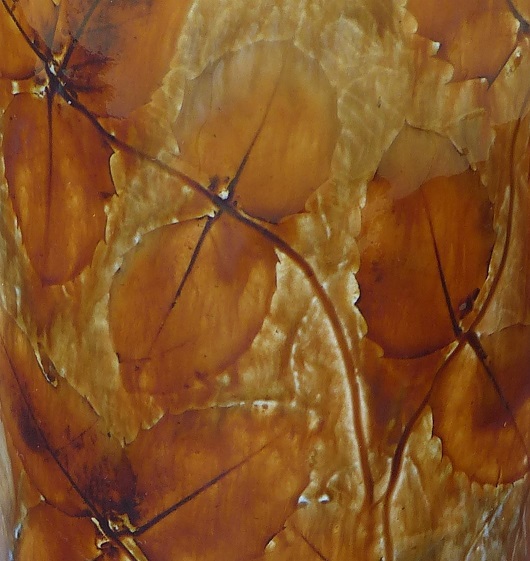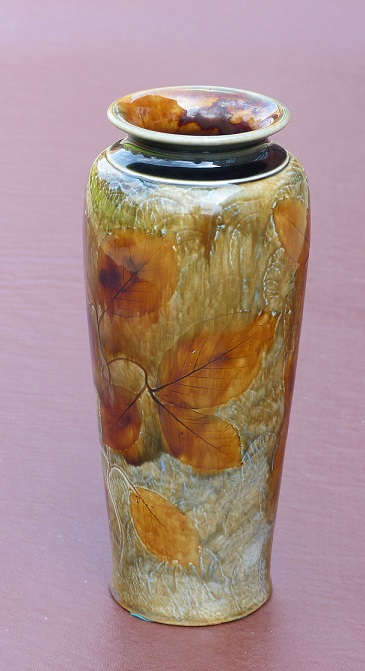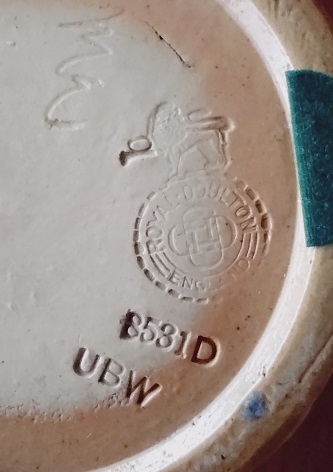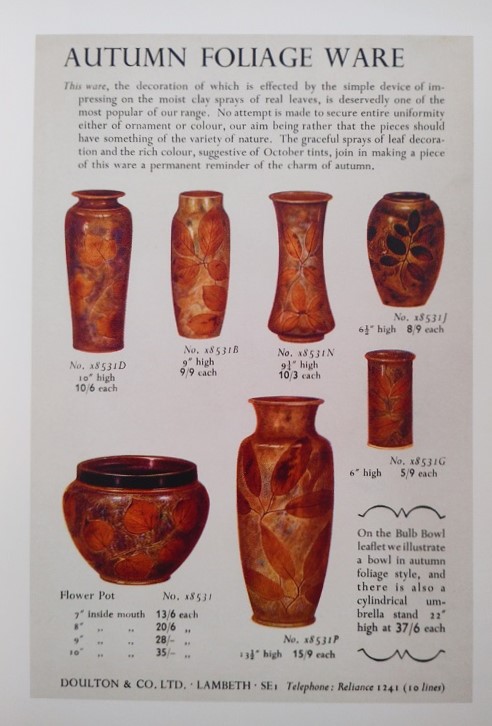
I saw my first example of a Royal Doulton Autumn Foliage vase in an auction about six years ago. I was immediately attracted to it and was surprised at its low estimate, around £30. To my mind it had a lot going for it. The vase was an attractive shape. l loved the subject matter and the use of subtle brown colours to pick out the leaves. Even better, being over a hundred years old it was a “proper antique” and yet it was still in perfect condition. It looked as good as the day it came out of the factory.
Of course, as is often the case at auctions, when it came to bidding time the low estimate proved meaningless and I was completely outbid. I don’t recall where the bidding ended, but it was the far side of £100 and I just hadn’t been prepared for that. Thus, the vase became one of the first entries on my (virtual) list of “things that got away at auction”. It’s a long list these days, but it’s got some fantastic stuff on it.
Once you’ve seen something you see it everywhere
It happens a lot with antiques, once you’ve noticed and taken an interest in something, you start to see examples all over. Since my first encounter with an Autumn Foliage vase I reckon I saw a piece every few months at auctions or in antique shops. Each one reminded me of the one that got away and each one seemed either not as nice a design or too expensive.
Shortly after being outbid on that first example I was watching an episode of the BBC television program “Bargain Hunt” where one of the teams purchased an Autumn Foliage vase. When it came to being valued by the auctioneer his comments were very positive but he said they don’t tend to sell for much. In the televised auction the vase sold for a reasonable amount, but less than I’d experienced. That gave me hope I could find one at a bargain price.
The next piece I saw that I really liked was in an antiques shop at Moreton-in-Marsh. The vendor was asking a very reasonable retail price, about £80. That made me think I could probably hope to get a nice vase at about £40 on the hammer. If 100% mark up seems a lot for a dealer, remember that they have to pay buyer’s premium on the hammer price that can be as much as 37%. Then, when they sell an item through a shop, the shop will generally take about 7%. On top of that, a savvy buyer will ask for a discount too. I’ll write more about this sometime, but if a dealer makes 25% profit on an item bought at auction and sold through a shop they are doing well. A 15% profit is probably more usual.

The Autumn Foliage vase I finally managed to purchase
Ironically I finally succeeded in getting my vase by buying two pieces of early 20th century Royal Doulton ceramics together at an auction. I was lucky and actually paid considerably less than I’d seen any single Autumn Foliage piece sell for. It sometimes happens this way and if you’re selling through an auction it’s good to be aware of it. Auctioneers will sometimes group what they think are low value items into a single lot, the idea being that will increase the overall value. However this isn’t always the case as it can cause buyers to stop bidding at the value of the piece they want. If they win, they effectively take the remainder of the lot for next to nothing.
The history of the Autumn Foliage Ware
Autumn Foliage Ware is the series name that came to be used for quite a wide range of Doulton salt glazed stoneware. Production began in 1883 and continued for almost 70 years although apparently at a lower level in the later years. Because of the longevity of production, some pieces are marked Doulton but those from 1902 onwards are marked Royal Doulton.
The design was achieved by pressing real leaves into the surface of the wet clay to make an impression. The leaves were then removed and the impression was then very carefully painted. In the example I have, the leaves are a mix of Beech and Holly but I’ve seen others that used Ivy and I think Laurel. The design works best where large, robust leaves with strong veins and a distinctive shape are used as the technique picks out the details beautifully.
Because of the way the design was produced every piece is unique, even those that were sold through catalogues of standard vase shapes. An avid collector would be hard pressed to get anything near “a full set”, which of course is ideal if you’re making and selling them!
Collecting Autumn Foliage Ware
An Autumn Foliage Ware collection is not going to cost you a vast amount. Having been produced for such a long period there were plenty of pieces to start with and it seems that plenty have survived. Large and imposing ceramics are always impressive so it’s hard to imagine many pieces being simply discarded.
A great feature of the salt glazed stoneware is its robustness. It survives the occasional knock whilst being moved or dusted and the designs have few, if any, edges or corners to get chipped or cracked. Doulton salt glaze is brilliant stuff. It’s proven itself to be stable over the hundred and fifty years since the early production. It doesn’t degrade or craze when exposed to the normal range of temperatures experienced in domestic settings. Thus the pieces should look as good today as they ever did.
There’s usually a good selection available online for sale. As I write this I can see about twenty pieces in the UK being listed. If you’re interested, be aware that a lot of dealers and private sellers are very imprecise about research and naming so look for “Autumn Foliage” (the correct name) as well as variations on “Autumn Leaves”. Don’t be put off by the use of the terms “Doulton”, “Doulton Lambeth” and “Royal Doulton” either. These do have “correct” meanings but they are often incorrectly interchanged and for the Autumn Foliage ware any could be correct depending on the time of production.
Doulton wares are usually well marked on the base with design codes, information relating to the designer and artist and sometimes other marks that hint at the date and location of production. This adds greatly to the enjoyment of collecting as it gives you the chance of dating the piece and sometimes being able to put a name to who actually made it. Some of the artists are only known by name but for some short biographies are available with a little research.

The base markings on my vase showing the design code, the Royal Doulton stamp and the artist’s mark
In the case of my vase shown above, the artist’s mark looks like the “MW” used by Minnie Webb. “The Doulton Lambeth Wares” by Eyles and Irvine depicts Minnie’s mark and states that she was a Senior Assistant Artist working around 1925. The excellent Doulton Artists website entry is here: https://www.doultonartists.co.uk/minniewebb.html
Has my vase increased in value?
Reading the excellent book “The Doulton Lambeth Wares” by Eyles and Irvine I was delighted to find an image of an advert from 1935 for a number of Autumn Foliage Wares. By coincidence, the vase I have is actually depicted and given a price.

A 1935 advert for Royal Doulton Autumn Foliage Ware, taken from “The Doulton Lambeth Wares” by Eyles and Irvine
A common question when someone asks about the value of an antique is Has it increased in value? With the aid of the advert, for my vase I can get something of an answer:
Item code x8531D at 10 inches high would have cost you 10/6 (i.e. 10 shillings and 6 pence) in 1935. A quick internet search tells me that 10/6 in 1935 is now worth about £50.
I paid less than £50 for my vase but selling it retail I’d hope to get a bit more. So, has it increased or decreased in value? Probably a little increase in value but it wouldn’t make you rich. Of course, popularity of Doulton has varied over time too and at present only the high end pieces retain a premium value. In the future though who knows, but at £50 per vase you’re not going to lose a lot building up a little collection?
Really interesting, thank you. I inherited a couple of Autumn Foliage pieces from my mums cousin. My auntie wanted to stick them in a car boot sale but I loved them and so persuaded her to let me keep them. From your article I can confirm I too have a Minnie Webb 🙂 which is a 7’ flower pot. I also have a piece that isn’t in the advert and have never seen its shape anywhere on the internet and was wondering if you had seen it in your investigations. It is quite a large bucket type shape and I think is a little earlier than my Minnie. Thanks, Vicki
I think jardinieres were quite commonly decorated with the Autumn Foliage pattern. A very appropriate design given their intended use! Does that sould like what you have?
Being made with thick walls they are very robust and so there seem to be quite a lot of survivors. I’ve seen a couple recently come up for auction. They never seem to go for much but they are really good things.
Doulton, of course, had plenty of experience in making items that were meant to be used (everything from industrial containers, through to drinking pots, drain pipes and toilets) so a big plant holder would have been no problem for firing.
I’m sure it is some sort of plant pot and that is what I use it for in my conservatory. It doesn’t have any artists mark on the bottom like the other one but it has a stamp inside which looks like M M LIND. I know they don’t make loads of money at auction but I love the fact that it is old and as my maternal family came from Lambeth I reckon they have been in the family from new. Thanks for the info.